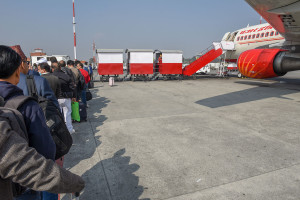Miscellaneous
Saving culture and history
It was a particularly hot day.
Chahana Sigdel
Helping them were daily wage workers and at least 50 young volunteers, some of them as young as 15. They had all formed a human chain around the rubble and were now passing bricks salvaged from the site, to be piled neatly on the side.
“It is my culture, my heritage and my responsibility,” said seventeen-year-old Jemi Shrestha as she passed the bricks along. Her friends murmured in agreement.
Such community support and a sense of responsibility could be of great use in documenting monuments, said Joy Lynn Davis, an American artist who is known for her research on stolen sculptures. Her recent project, Remembering the Lost, documents community response to the theft of stone sculptures in the Valley.
Just two days after the quake, Davis had the idea of coming up with a common platform to document damaged monuments, an idea she shared with Prabas Pokharel at Kathmandu Living Labs. A few days later, they had started using the KLL Collect app, gathering information on damaged or destroyed cultural sites within the Valley.
Kathmandu Livings Labs (KLL) has been in the limelight in the aftermath of the quake for spearheading digital volunteerism. Till date, they have mapped around 70-80 percent of the quake-ravaged areas and plotted the number of missing people, blocked roads and destroyed villages, thus helping to facilitate relief programmes.
The app, designed by Nirab Pudasaini of the team, was launched a few months ago and is now being used to document damaged monuments. It relies on geo-location for its functioning and is built for android-based phones only. Users can upload up to five pictures of damaged monuments before pressing ‘send’. The information then goes to a database, which is then assessed by the Department of Archaeology before it reaches the public domain. According to Megha Shrestha, who works at the labs, they have collected information on 144 monuments so far.
Around 700 heritage sites in the country have been damaged or destroyed by the earthquake. While the Kathmandu Valley, which is home to seven Unesco World Heritage Sites, saw the most damage to heritage sites, other districts have also been hit hard. Sindhupalchok, Dolakha, Kavre, Makwanpur, Nuwakot, Tanahun, Kaski, Mustang, Bara, Parsa, Dhanusha, Ramechhap, Sindhuli, Rasuwa, Lamjung and Gorkha also witnessed severe damage to their ancient historical and cultural sites.
Community mobilisation will be the key to the success of long-term projects, said Nischal Oli, coordinator at the Siddhartha Art Foundations. The technology-savvy generation, well versed in digital media, could be tapped to collect information on sites that might slip through the cracks.
“The Kathmandu Valley is a treasure trove of culture, thus we need all hands on deck. Youth interested in helping out should realise that they now have an opportunity to safeguard it for the future,” said Oli.




 19.12°C Kathmandu
19.12°C Kathmandu










